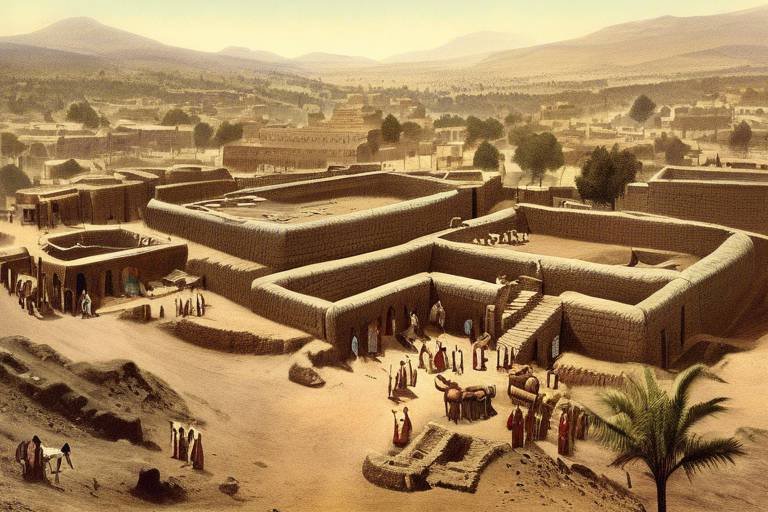The Influence of the Roman Empire on the Celts
When exploring the profound impact of the Roman Empire on the Celts, one cannot help but marvel at the intricate web of influence that was woven between these two ancient civilizations. The Roman conquest of Celtic lands marked a pivotal moment in history, ushering in a new era of cultural exchange, assimilation, and resistance that would shape the trajectory of both societies for centuries to come.
As the mighty legions of Rome marched across Celtic territories, a wave of military campaigns and strategic maneuvers unfolded, leading to the subjugation of Celtic tribes and the integration of their lands into the vast expanse of the Roman Empire. The clash of swords and shields gave way to a complex tapestry of political alliances, economic transformations, and social reorganizations that would forever alter the fabric of Celtic society.
Amidst the tumult of conquest, a fascinating process of cultural exchange and assimilation took root, as Romans and Celts mingled, traded, and intermingled in a kaleidoscope of customs, languages, and technologies. The once distinct boundaries between Roman and Celtic worlds began to blur, giving rise to a rich tapestry of shared traditions, beliefs, and practices that reflected the intricate dance of two civilizations in flux.
Religious syncretism emerged as a hallmark of this interaction, as Celtic and Roman spiritual beliefs intertwined, giving rise to a pantheon of deities, rituals, and ceremonies that reflected the fusion of ancient traditions with new influences. The sacred groves of the Celts echoed with the chants of Roman prayers, while the temples of Rome bore witness to the reverence of Celtic gods, forging a spiritual bond that transcended the boundaries of culture and creed.
Yet, amidst the backdrop of assimilation, pockets of resistance and revival flickered like embers in the night, as Celtic tribes rallied against Roman occupation, seeking to preserve and revitalize their identity, language, and heritage in the face of imperial dominance. The echoes of Celtic defiance reverberated through the hills and valleys, a testament to the enduring spirit of a people determined to safeguard their legacy against the tides of history.
Today, the legacy of Roman influence on Celtic culture endures, etched in the stone carvings of ancient ruins, the lyrical cadence of Celtic languages, and the intricate patterns of Celtic art and architecture. The echoes of a bygone era linger in the wind, reminding us of the enduring bond forged between two civilizations in the crucible of conquest and camaraderie.

Roman Conquest of Celtic Lands
The Roman conquest of Celtic lands marked a significant turning point in the history of both civilizations. The Romans, known for their military prowess and strategic acumen, embarked on a series of campaigns to subdue the Celtic territories scattered across Europe. Utilizing advanced military tactics and superior weaponry, the Roman legions gradually expanded their control over Celtic regions, imposing Roman authority and governance.
Through a combination of military might and diplomatic maneuvers, the Romans succeeded in integrating Celtic lands into their vast empire. This conquest not only reshaped the geopolitical landscape of Europe but also brought about profound changes in Celtic society, culture, and daily life. The once fiercely independent Celtic tribes found themselves under the rule of the mighty Roman Empire, adapting to a new way of life imposed by their conquerors.
The Roman conquest was not merely a military endeavor but also a cultural exchange between the Romans and the Celts. As Roman influence spread throughout Celtic territories, elements of Roman civilization began to permeate Celtic society. The Celts, known for their distinct customs and traditions, gradually adopted Roman practices, language, and technology, leading to a fusion of cultures that influenced the development of both civilizations.
Moreover, the Roman conquest brought about a reorganization of Celtic social structures and governance. The hierarchical system of the Romans influenced the traditional tribal structures of the Celts, leading to a shift in power dynamics and societal norms. Roman administrators introduced new forms of governance, taxation, and law enforcement, altering the fabric of Celtic society and paving the way for a more centralized authority.
Economically, the Roman influence on Celtic lands was profound. The establishment of trade networks, the introduction of Roman currency, and the adoption of advanced agricultural practices transformed the economic landscape of the Celtic regions. The integration of Celtic territories into the Roman economy facilitated the exchange of goods and services, contributing to the prosperity and development of both civilizations.
Despite the Roman conquest, Celtic resistance against Roman occupation persisted in various forms. Some Celtic tribes fiercely opposed Roman rule, engaging in rebellions and uprisings to defend their autonomy and cultural heritage. These acts of resistance, coupled with efforts to preserve Celtic identity, language, and heritage, underscored the enduring spirit of the Celtic people in the face of foreign domination.
As we delve into the history of the Roman conquest of Celtic lands, it becomes evident that the interactions between these two ancient civilizations have left a lasting impact on the cultural heritage of Europe. The legacy of Roman influence on Celtic culture, language, art, and architecture continues to shape our understanding of the Celts and their place in history, highlighting the complex dynamics of conquest, assimilation, and resistance that defined this pivotal period.

Cultural Exchange and Assimilation
Exploring how Roman conquest impacted Celtic culture, religion, and society, and analyzing the lasting effects of this interaction on the Celtic tribes across Europe.
Detailing the military campaigns and strategies employed by the Romans to subdue Celtic territories and the subsequent integration of these regions into the empire.
When the mighty Roman Empire clashed with the Celtic tribes, a fascinating cultural exchange ensued. The Celts, known for their rich traditions and fierce independence, found themselves exposed to the advanced Roman civilization. This encounter led to a profound assimilation of Roman customs, language, and technology within the Celtic population. The once distinct boundaries between the two cultures began to blur, giving rise to a unique blend of traditions and practices.
Examining the blending of Celtic and Roman religious practices, deities, and rituals, and how this syncretism influenced the spiritual beliefs of both cultures.
Analyzing the impact of Roman rule on Celtic social structures, governance, and daily life, and how these changes reshaped the traditional Celtic societal norms.
Discussing the economic shifts brought about by Roman influence, such as trade networks, agricultural practices, and the introduction of Roman currency in Celtic regions.
Exploring instances of Celtic resistance against Roman occupation, as well as efforts to preserve and revitalize Celtic identity, language, and heritage in the face of Roman dominance.
Reflecting on the enduring legacy of Roman influence on Celtic culture, language, art, and architecture, and how this historical interaction continues to shape modern perceptions of the Celts.
Drawing parallels between the Roman conquest of the Celts and similar imperial expansions in history, highlighting the unique aspects of Roman-Celtic interactions and their broader implications.
Stay tuned for answers to common queries about the impact of the Roman Empire on the Celts!

Religious Syncretism
Religious syncretism between the Romans and Celts was a complex and multifaceted process that significantly impacted both cultures. The blending of Celtic and Roman religious beliefs, deities, and rituals led to a unique fusion of spiritual practices that shaped the religious landscape of the time. The Celts, known for their reverence of nature and connection to the spiritual world, encountered the structured pantheon of Roman gods and goddesses, leading to a gradual assimilation of deities and religious practices.
This syncretism resulted in the emergence of hybrid religious traditions that incorporated elements from both Celtic and Roman belief systems. Celtic deities were often equated with Roman counterparts, creating a new religious framework that reflected the shared cultural interactions between the two civilizations. The integration of Celtic religious sites, such as sacred groves and temples, with Roman religious practices further solidified this syncretic approach to spirituality.
Moreover, the syncretism of Celtic and Roman religious rituals and ceremonies fostered a sense of unity and shared spiritual experience among the Romanized Celts. The incorporation of Roman festivals, such as Saturnalia and Lupercalia, into Celtic religious calendars underscored the evolving nature of religious syncretism and the mutual influence between the two cultures.
Overall, religious syncretism played a pivotal role in shaping the spiritual landscape of the Roman Empire and Celtic territories, highlighting the dynamic interplay between different belief systems and the capacity for cultural exchange to transform religious practices. This blending of traditions not only enriched the spiritual lives of both Romans and Celts but also laid the foundation for future developments in religious syncretism and cultural integration.

Social Reorganization
When the mighty Roman Empire clashed with the ancient Celtic tribes, a profound transformation swept across the lands. The that ensued under Roman rule was nothing short of revolutionary. The traditional Celtic societal structures faced a seismic shift as Roman governance took hold, reshaping the very fabric of daily life for the Celtic people.
Under Roman influence, Celtic communities experienced a reconfiguration of their governance systems, with Roman administrative practices replacing traditional tribal leadership. The introduction of Roman laws and institutions brought a new order to Celtic society, altering power dynamics and legal frameworks.
Moreover, the Roman presence led to the establishment of urban centers in Celtic territories, fostering a shift from rural agrarian lifestyles to more urbanized living. The construction of roads, aqueducts, and public buildings transformed the landscape, bringing a sense of Roman urban planning to Celtic regions.
As Celtic society adapted to Roman influence, new economic opportunities emerged. Trade networks expanded, connecting Celtic lands to the vast markets of the Roman Empire. The introduction of Roman currency facilitated commercial transactions and stimulated economic growth, leading to the development of a more interconnected and prosperous Celtic economy.
Furthermore, the Roman impact on social stratification within Celtic communities cannot be overlooked. The emergence of a Roman-influenced elite class alongside traditional Celtic social hierarchies created a complex social structure that reflected the fusion of Roman and Celtic norms.
In essence, the brought about by Roman conquest reshaped the very essence of Celtic society, blending Roman administrative practices, urban development, economic integration, and social stratification to create a new cultural landscape that bore the marks of both civilizations.

Economic Transformation
During the Roman conquest of Celtic lands, one of the most significant impacts was the brought about by Roman influence. This transformation encompassed various aspects of Celtic society, ranging from trade networks to agricultural practices and the introduction of Roman currency in Celtic regions. The Romans introduced advanced agricultural techniques, such as irrigation and crop rotation, which improved the productivity of Celtic lands. This led to increased agricultural output and surplus production, fostering economic growth and stability within the Celtic communities.

Resistance and Revival
Resistance and Revival during the Roman conquest of Celtic lands marked a pivotal period in Celtic history. Despite facing overwhelming military power, Celtic tribes fiercely resisted Roman occupation, clinging to their cultural identity and heritage. The Celts showcased remarkable resilience in the face of adversity, engaging in guerrilla warfare tactics and strategic alliances to challenge Roman dominance.
One notable example of Celtic resistance was the legendary Queen Boudica of the Iceni tribe, who led a massive uprising against Roman forces in Britain. Boudica's rebellion symbolized the spirit of Celtic defiance and determination, inspiring future generations to uphold Celtic traditions and values.
Alongside resistance, Celtic communities embarked on a journey of revival, seeking to preserve their language, customs, and spiritual beliefs amidst Roman influence. Druidic traditions played a crucial role in this revival, serving as a unifying force for Celtic tribes and a repository of ancient knowledge and wisdom.
Despite the challenges posed by Roman conquest, the Celts demonstrated a remarkable ability to adapt and evolve, blending their rich cultural heritage with elements of Roman civilization to create a unique fusion of traditions. This period of resistance and revival laid the foundation for the enduring legacy of Celtic culture and identity that continues to resonate in modern times.

Legacy of Roman Influence
When examining the on Celtic culture, it becomes evident that the impact was profound and far-reaching. The Romans not only left their mark on the physical landscape through architecture and infrastructure but also influenced the very essence of Celtic identity. The fusion of Roman and Celtic artistic styles gave rise to unique forms of expression, evident in intricate metalwork and elaborate stone carvings that still captivate observers today.
Moreover, the introduction of Roman governance systems and legal frameworks reshaped the way Celtic societies functioned, laying the groundwork for future political structures. The enduring presence of Roman roads and urban planning in Celtic regions speaks to the lasting imprint of Roman engineering prowess on the landscape, facilitating trade and communication long after the empire's collapse.
One cannot overlook the linguistic impact of Roman conquest on Celtic languages. While Latin became the language of administration and trade, elements of Celtic tongues persisted, leading to a linguistic tapestry that reflects the complex interplay of cultural exchange and adaptation. The blending of linguistic elements serves as a testament to the enduring nature of cultural syncretism between the two civilizations.
Furthermore, the influence of Roman art and mythology on Celtic artistic traditions is unmistakable. Themes of Roman mythology intertwined with Celtic folklore, resulting in a rich tapestry of stories and symbolism that continue to resonate in modern interpretations of Celtic culture. The intricate blend of artistic motifs highlights the dynamic nature of cultural exchange and the enduring legacy of Roman influence on Celtic artistic expression.

Comparative Analysis with Other Conquests
When comparing the Roman conquest of the Celts with other imperial expansions throughout history, it becomes evident that the interaction between these two ancient civilizations holds unique significance. Unlike some conquests that resulted in complete obliteration of the conquered culture, the Roman influence on the Celts was marked by a complex interplay of assimilation and resistance. The Celts, known for their fierce independence and rich cultural heritage, offered a formidable challenge to the Roman forces, leading to a dynamic exchange of ideas, technologies, and traditions.
While the Romans sought to assert their dominance over the Celtic lands through military might and political control, the Celts fiercely defended their territories, often resorting to guerrilla tactics and strategic alliances to resist Roman encroachment. This ongoing struggle for power and autonomy shaped the nature of Roman-Celtic interactions, setting it apart from other conquests characterized by swift subjugation and cultural erasure.
Moreover, the legacy of Roman influence on the Celts extends beyond the period of conquest, with lasting effects on Celtic art, language, and societal structures. The syncretism of Roman and Celtic religious practices, the adoption of Roman technology and agricultural methods, and the integration of Celtic elites into the Roman political system all contributed to a complex cultural tapestry that continues to intrigue historians and archaeologists to this day.
By examining the Roman conquest of the Celts in comparison to other conquests in history, we gain a deeper understanding of the complexities of imperial expansion and cultural exchange. The Roman-Celtic interaction serves as a compelling case study of how conquests can shape the identities of both the conquerors and the conquered, leaving a legacy of innovation, conflict, and resilience that reverberates through the annals of history.
Frequently Asked Questions
- What impact did Roman conquest have on Celtic culture?
The Roman conquest significantly influenced Celtic culture through the adoption of Roman customs, language, and technology. This interaction led to a cultural exchange between the two civilizations, resulting in a blending of traditions and practices.
- How did the Romans integrate Celtic territories into their empire?
The Romans employed military campaigns and strategies to subdue Celtic lands, eventually integrating these regions into their empire. This conquest led to social reorganization, economic transformations, and religious syncretism between the Roman and Celtic populations.
- What was the legacy of Roman influence on Celtic society?
The enduring legacy of Roman influence on Celtic society can be seen in various aspects of culture, language, art, and architecture. This historical interaction continues to shape modern perceptions of the Celts and their unique identity in the broader historical context.



















